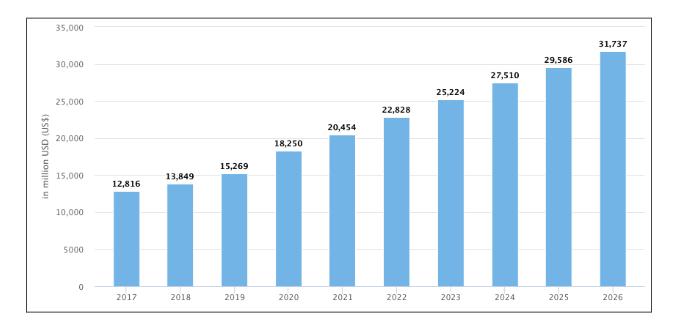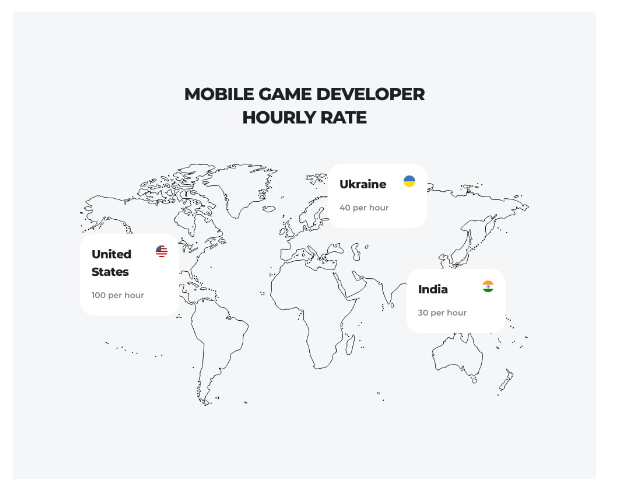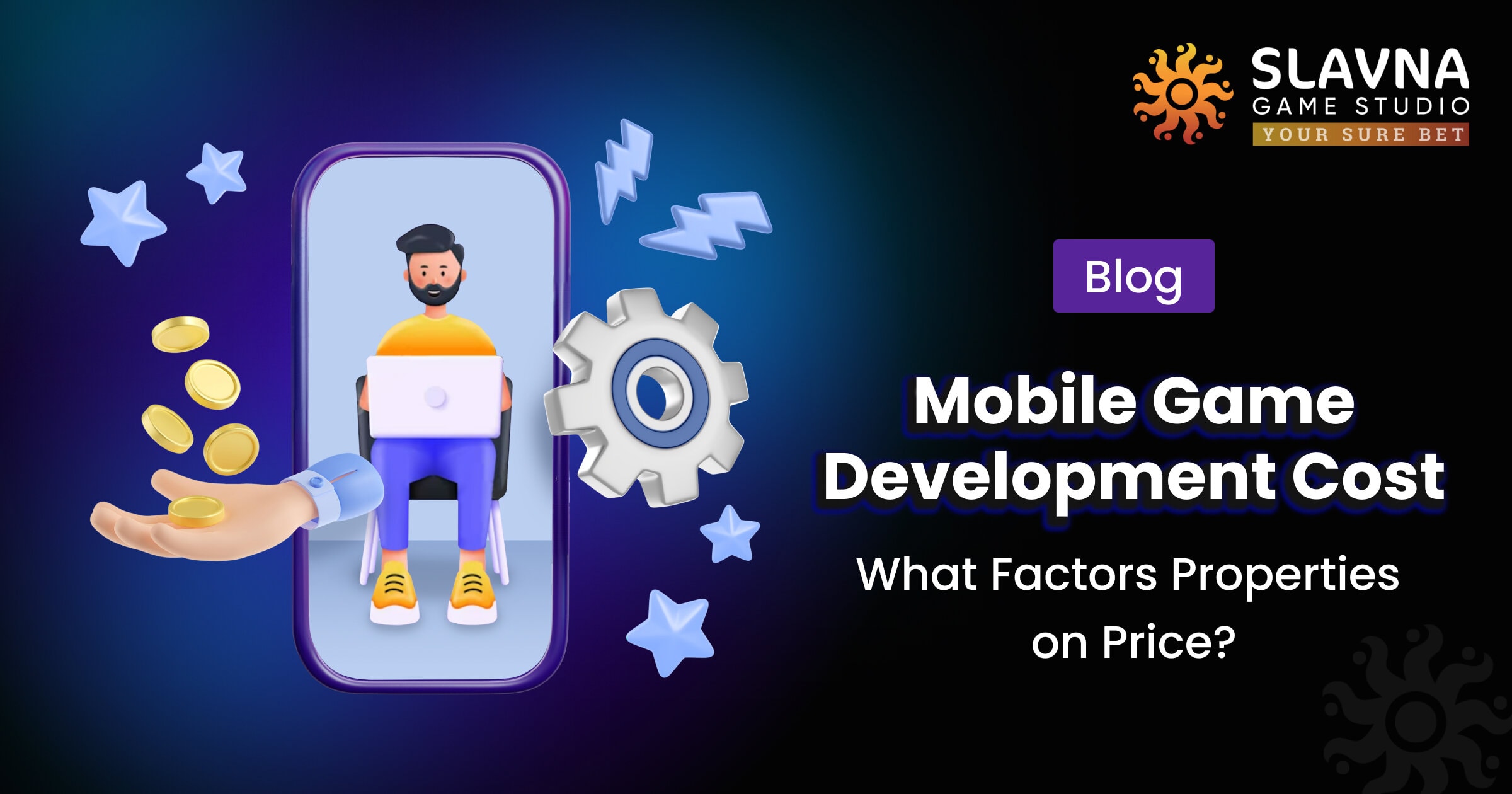Have you ever envisioned a one-of-a-kind game concept? If the answer is yes, then the next crucial step is to breathe life into your project and find out how much does it cost to make a video game.
Crafting a budget for your game venture demands a meticulous evaluation of these elements. From the initial stages of planning to the intricate features and the chosen gaming platform, each facet plays a pivotal role in shaping your budget.
Understanding the Scale of Mobile Game Development
The extent of mobile game development can fluctuate based on the specific project. Smaller endeavors may be successfully executed by one or two developers within a few months. In contrast, larger-scale projects often necessitate the collaborative efforts of a development team and extend the timeline for completion considerably.
It’s important to note that the price of game development is intricately linked to the size and scope of the project, with larger and more complex ventures typically incurring higher expenses.
The Meaning and Impact of Mobile Game Development Costs
The expenditure required for mobile game development is referred to as Mobile Game Development Cost. This cost is subject to significant variation depending on elements like the game’s genre, its level of intricacy, and the size of the development team participating. However, several general factors come into play, influencing the overall cost.
One crucial factor is the number of platforms the game must be compatible with. The development team may face increased costs when creating a game for multiple platforms due to the additional workload involved.
Another pivotal factor revolves around the level of graphics and animation demanded by the game. Games with intricate graphics and animations typically incur higher development costs than less complex alternatives.
Mobile Gaming Industry Overview
The Market is thriving, establishing itself as one of the most rapidly expanding sectors worldwide. Let’s delve into market statistics to gain a deeper understanding.

- In 2022, the mobile games revenue in the United States, as reported by Statista, reached an estimated $22,828 million, marking substantial growth from $18,250 million in 2020.
- The robust growth of the US market paves the way for innovative game development. Notably, games like COD: Mobile and PUBG Mobile have achieved remarkable revenue milestones, with COD: Mobile reaching $500 million and PUBG Mobile soaring to an impressive $2.6 billion in revenue over the past two years.
- Globally, there were approximately 2,659.5 million players in 2021, underscoring the vast reach and popularity of mobile gaming.
- Projections indicate that the mobile gaming industry is set to continue its growth trajectory, with an expected Compound Annual Growth Rate (CAGR) of 2.9% by 2024.
- In the United States, a noteworthy statistic reveals that more than 72% of mobile device users actively engage in mobile gaming, highlighting the widespread appeal of this form of entertainment.
Game Development Costs: What to Consider
When crafting a budget for mobile game development, it’s imperative to take numerous factors into account. In this article, we will delve into some of the primary factors that significantly impact the costs of developing a mobile game app.
Initial Investment: Navigating Pre-Production Expenses
The Game Design Document (GDD) serves as the comprehensive blueprint for a well-structured development process. It is undeniably a pivotal step, as it forms the bedrock upon which the entire project is built.
The creation of game design documents entails a significant investment of time and effort, and it plays a key role in the pre-development phase, impacting game development costs. These costs can be quantified by considering factors such as the cost per working hour.
Platform Decision-Making: A Cost-Critical Choice
When embarking on mobile game development, a crucial decision awaits – choosing between iOS, Android, or both platforms. This choice holds substantial sway over your game’s development costs, its potential reach, and revenue prospects.
While iOS game development comes with a notably higher price tag, it’s essential to note that Android continues to assert dominance in the mobile game market. Opting for iOS entails additional expenses, primarily attributed to the cost of administering and licensing Apple devices.
Single-platform development typically incurs lower costs compared to the complexity of developing a multi-platform application. However, there’s a trade-off to consider. Choosing a single platform limits your revenue potential from other platforms.
To maximize the benefits of each platform and reach a broader audience, many developers opt for cross-platform app development. Yet, it’s important to recognize that this choice can lead to higher mobile game development expenses.
In the end, the platform you choose should align with your budget and target audience, as it significantly influences the trajectory of your game development journey.
Crafting the Experience: The Cost of UI/UX Design
The process of how to make a mobile game unfolds in multiple layers, each bearing significant weight in shaping your game’s success. During this stage, critical decisions emerge, including defining your target users, structuring levels, crafting the game environment, and refining gameplay mechanics.
Designing an app without a meticulous design phase can lead to a proliferation of bugs and glitches, making this step a critical one in the development process.
In many cases, a collaborative effort involving UI/UX designers, architects, and game artists spans the entire design and development cycle. The fees associated with these professionals vary based on their expertise and capacity, underlining the importance of assembling a skilled team for this pivotal stage.
Quality Assurance: The Cost of Testing Your Game
Much like the game development phase, the testing process holds paramount importance. In the realm of gaming, the presence of bugs and glitches is simply intolerable. To deliver an unparalleled user experience and ensure your game runs seamlessly, it’s imperative to allocate resources for comprehensive testing services, particularly when collaborating with an iPhone app development company.
Genre Dynamics: Costs Varying by Mobile Game Types
The costs associated with app development can significantly vary based on the type of app you’re creating, whether it’s a simulation, social, or casual game. Game apps, in particular, exhibit diverse complexity levels and can be categorized as follows.
2D Casual Games: These budget-friendly games feature simple 2D graphics and a soundtrack. Despite their basic nature, they offer substantial potential for expansion and enhanced user engagement.
Mini-Games: Casual or mini-games are straightforward solitary games that don’t demand specific skills. Adjusting your game development budget may be necessary if you intend to incorporate more graphics or have higher expectations for the game app.
Mid-Level Games: Mobile games in this category are meticulously designed, boasting engaging storylines, character modeling, and a diverse array of levels. Their depth and variety of content keep players engaged for extended periods.
Social Games: Played by numerous users on social media platforms like Facebook, these games provide limited access to user information, akin to browser-based games. Developers often utilize SDKs offered by social platforms to create these games.
High-End Games: High-level games require a significant financial investment but offer substantial returns when targeting the right audience. Diligence in planning, strategy, and design is essential. The development costs for high-end games far surpass those of 2D or mini-games.
Business Games: Businesses leverage mobile games for team-building purposes, fostering creativity, enhancing communication, and creating an enjoyable work environment. These multiplayer games incorporate cross-platform compatibility, captivating graphics, compelling narratives, soundtracks, and diverse levels, making them essential for corporate engagement.
Complex Games, Simple Budgets: Navigating Development Expenses
Once you’ve established a game’s category and genre, the essential features that define it come into focus. For a straightforward game, integrating social media functionality may suffice.
However, the development of a complex game, such as PUBG, demands a host of additional features, including gyroscopes, voice integration, and more. These advanced functionalities elevate the intricacy of game development and, consequently, contribute to increased production costs.
Powering Your Game: Expenses Tied to Game Engines
The choice of game engines holds immense significance in shaping the cost of video game development. Therefore, the selection of a suitable game engine is pivotal, as the success of your mobile game hinges upon it. The right mobile game engine selection is contingent on various factors, including the game’s features, type, and category.
Within the Android and iOS app development market, a diverse array of mobile game development engines is available. Each option comes with its own set of advantages and drawbacks. Making a well-informed selection is essential, aligning your choice with your specific project needs.
Ensuring Financial Sustainability
Selecting the right game engine is just one piece of the puzzle when it comes to managing the costs of game development. Hidden expenses can emerge throughout the development journey, from legal fees to post-release support. Therefore, alongside making a well-informed engine choice, meticulous budgeting that considers both direct and indirect costs is essential. By understanding and accounting for these intricacies, you can navigate the complex landscape of game development while maintaining financial sustainability.

The United States is renowned for having the highest hourly labor costs, with local developers charging approximately $100 per hour. Given that mobile game development typically spans from 2 to 4 months.
Comparatively, Western Europe offers a somewhat more cost-effective option, with specialists charging around $80 per hour.
For the most budget-conscious approach, Eastern European developers are the ideal choice, with hourly rates ranging from $35 to $50.
Unveiling Hidden Costs in Game Development: A Comprehensive Overview
When you fully comprehend how to create a mobile game, knowing that the expenses linked to game production can extend beyond direct costs like salaries and licensing fees is crucial. Hidden costs can encompass legal expenses, post-release support, enhancements, and marketing and promotional activities. To maintain the financial sustainability of a game development project, it’s imperative to factor in these additional expenses when creating your budget.
Strategies for Cost Control in Game Development Projects
Balancing costs and demonstrating consistent quality from start to finish in the game production process are among the most formidable challenges. It’s essential to uphold the game’s quality even as developers strive to control expenses. This equilibrium can be achieved through strategies such as implementing well-defined growth plans, prioritizing essential features, and minimizing waste and inefficiency.
In-House vs. Outsourcing: Making Budget-Savvy Game Development Choices
Choosing between in-house developers or outsourcing development can substantially impact the expenses associated with game production. In-house development provides greater control over the process but can be costlier due to employee salaries, benefits, and associated expenses. Conversely, outsourcing game development can be more cost-effective, but ensuring that production aligns with the required standards and maintains high quality may necessitate heightened supervision.
Effective Game Development Budgeting: Tips and Best Practices
Considering the game production budget, it can indeed be a challenging task. However, creators can follow several guidelines and best practices to navigate this process effectively. Firstly, it’s essential to create a comprehensive budget for video game pricing that accounts for all potential expenses, both direct and indirect.
Once the budget is in place, diligent tracking of spending is crucial. This involves keeping a close eye on where the money is going throughout the development process. Regularly reviewing the budget is equally important to ensure that the project remains on a financially sustainable path.
The Price of Post-Release Support and Updates in Game Development
In your game production budget planning, you must include the expenses related to post-release support and updates. This consideration is crucial because, after a game’s release, creators often need to provide ongoing maintenance and updates to address issues, enhance gameplay, and keep players engaged.
Maintaining a game’s quality and addressing any bugs or issues that arise is vital for the long-term success of the game. However, it’s important to note that providing continuous care, especially for larger games that require frequent updates, can be expensive.
The expenses related to post-release support may include the allocation of resources for bug fixes, the creation of new content, and ensuring that the game remains compatible with evolving platforms and technologies. These costs can accumulate over time, making it necessary to budget for them appropriately to ensure the game’s sustained success and player satisfaction.
Unlocking Cost Benefits: How Outsourcing Reduces Game Development Expenses
Outsourcing game development offers several significant advantages, with cost savings for video game prices being the foremost benefit. When you opt for outsourcing, you benefit in the following ways:
Optimizing Budgets for Efficiency
- You pay solely for the actual time developers dedicate to your game project.
- Expenses related to equipment, workspace, and utilities are not your concern.
- You are not responsible for providing social benefits or covering vacation and sick leave costs, which can represent a substantial portion of in-house or remote team expenditures.
- These cost-related factors alone make outsourcing an attractive option compared to maintaining an in-house team, even a remote one. Furthermore, outsourcing firms adhere to pre-agreed budgets, clearly defined in the development agreement, and provide detailed expenditure reports, ensuring full transparency regarding the allocation of your funds.
- Additionally, working with an outsourcing company streamlines the hiring process, saving both time and money when compared to engaging separate freelance developers.
Accelerating Development Timelines
- If your business doesn’t primarily focus on game development, the necessity of assembling a dedicated team of developers becomes apparent. Even if you have an in-house team of software developers proficient in crafting standard applications, game development often demands a different skill set, as mobile games typically rely on distinct programming languages.
- Conversely, if your company is primarily engaged in game development, there may be critical tasks that warrant the attention of your in-house team, while others can be outsourced seamlessly. In some instances, you might require temporary team expansion, either to expedite game launches or to scale up your game development efforts rapidly.
- The process of recruiting an in-house team of game developers is not only time-consuming but also financially burdensome. Your HR and recruiting departments will need to identify suitable candidates, conduct interviews, negotiate employment terms, and provide them with the necessary workspace and equipment. Subsequently, onboarding and integrating new hires into your existing processes further prolong the timeline for game development.
- On the contrary, outsourcing, especially through an established outsourcing game development company, streamlines the process significantly. It entails the search for an appropriate partner whose team is already well-coordinated and operates with established processes, reporting mechanisms, and communication protocols. Once you finalize the contract and outline the requirements, development can commence promptly.
Scaling Up with Agile Solutions
- Outsourcing game development offers inherent flexibility compared to maintaining an in-house team. Game development involves varying demands for specialists at different stages, and this need fluctuates repeatedly throughout a project’s lifecycle. In contrast, an in-house team requires continuous employment and compensation, even during periods of inactivity.
- Opting for an outsourcing team grants you the freedom to scale your workforce up or down as the project demands. This agility allows you to expand the team when necessary and reduce the number of team members during downtime, optimizing resource allocation and cost-effectiveness.
Minimizing Development Risks
- Every business inherently carries its share of risks, a universal truth that applies across the board. When you choose to outsource mobile game development, you essentially invest in a partner who shares these risks with you, among other benefits. This risk-sharing encompasses various uncertainties, including market fluctuations and technical challenges. A reputable outsourcing company is well-equipped to anticipate and address these potential obstacles, thanks to their extensive experience in the field. Their commitment to meeting deadlines is reinforced by contractual agreements that may impose penalties for non-compliance, a level of accountability typically absent when working with an in-house team.
Speeding to Market Success
- Outsourcing companies often collaborate with numerous clients, and this dynamic reinforces their commitment to meeting deadlines with precision. The inherent necessity of transitioning to the next project upon completion of drives them to adhere rigorously to timelines. Central to the essence of outsourcing is the adept management of time, a relentless pursuit of eliminating potential delays, and the optimization of processes to ensure punctuality without compromising on quality.
Enhancing Development Focus
- When it comes to mobile game outsourcing, you have the flexibility to determine your level of involvement in the development process. If you prefer to maintain continuous communication with the individuals working on your game, that option is available. Conversely, you also have the choice to entrust your game to your selected partners and request updates at designated intervals. This approach allows you to allocate your own time to business management and expansion, as well as preparations for the game launch, such as organizing marketing campaigns.
Injecting Creativity from External Sources
- Outsourcing companies typically maintain a diverse pool of specialists capable of serving a broad spectrum of potential clients. Collaborating with a mobile game development outsourcing team can introduce fresh perspectives and innovative solutions, thanks to the diverse experiences and expertise of its members.
Open Mobile games market with Slavna Games Studio
The above-given tips can help you to choose the best partner for developing the game you need. However, when embarking on the journey of creating an engaging and addictive game, selecting the right team is paramount.
At Slavna Game Studio, we firmly believe that entertainment holds a central place in life. While your users become engrossed in gameplay, our team remains dedicated to crafting your mobile game to perfection.
Are you wondering how much it would cost to create your Mobile Game App? Our experts might have an answer – just contact us for a free consultation today!

